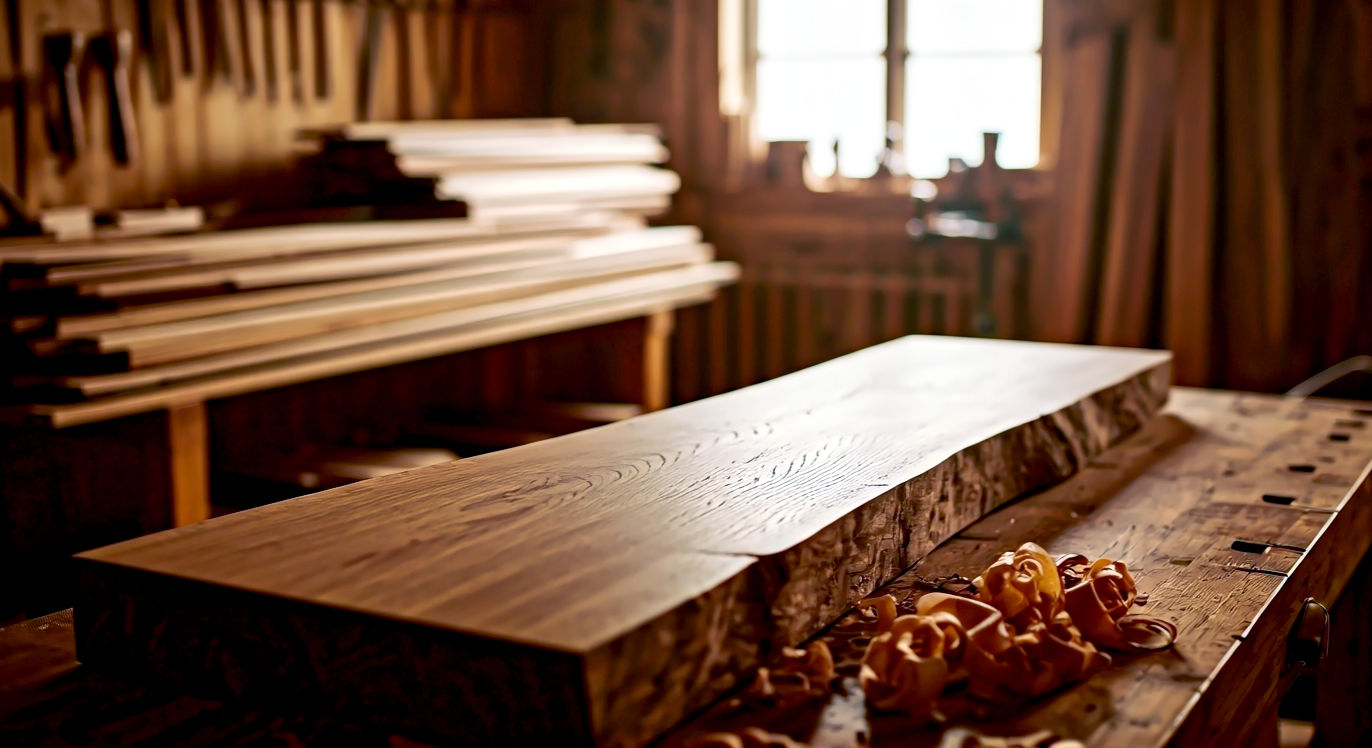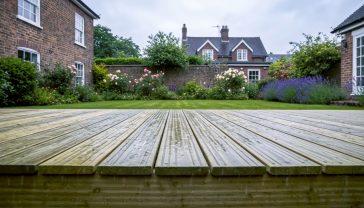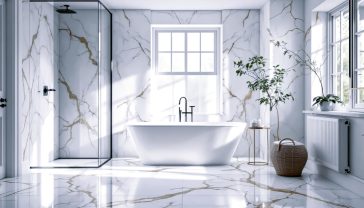The Definitive Guide to Hardwood: From Ancient Oaks to Your Kitchen Table
Discover everything you need to know about hardwood in the UK. From its role in British history to choosing the right wood for your home.

This post may contain affiliate links. If you make a purchase through these links, we may earn a commission at no additional cost to you.
Walk into almost any historic British building—a grand cathedral, a cosy pub, or a stately home—and you’re standing amongst giants. Not people, but trees. Or, at least, what’s left of them. The sturdy beams holding up the roof, the polished floorboards under your feet, the intricate bar you lean against—chances are, they’re all made of hardwood. It’s the silent backbone of our history, from the warships that built an empire to the kitchen table where you eat your breakfast.
But what actually is hardwood? We use the word all the time, usually to mean something is strong, durable, and a bit posh. We know it’s different from softwood, the stuff used for cheap furniture or fence posts. Yet, the real story is a bit more complex and a lot more interesting. It’s a tale of biology, history, and craftsmanship that has shaped our nation.
Forget complicated science for a moment. Think of it like this: hardwood is the story of a tree that took its time. It grew slowly, weathered British storms, and developed a dense, complex structure. This guide will take you on a journey into the heart of these remarkable trees. We’ll explore where hardwood comes from, how it became so important to Britain, and how to choose the right type for your own home. By the end, you’ll see wood not just as a material, but as a piece of living history.
What on Earth is Hardwood, Anyway?
You might think the difference between hardwood and softwood is simple: one is hard, the other is soft. It sounds obvious, right? But in the world of trees, things aren’t quite so straightforward. The real difference has nothing to do with how tough the wood feels and everything to do with how the tree makes its seeds.
The Secret’s in the Seed: Angiosperms vs. Gymnosperms
Let’s break it down without getting too technical.
- Hardwoods come from angiosperm trees. That’s a fancy Greek word for a plant that has flowers and produces seeds with a coating. Think of an acorn from an oak tree or a conker from a horse chestnut. The seed is enclosed inside a fruit or a nut. These trees are almost always deciduous, meaning they lose their leaves in the autumn. Common British examples include oak, ash, beech, and elm.
- Softwoods, on the other hand, come from gymnosperm trees. This means “naked seed.” Their seeds don’t have a protective casing and are instead dropped from cones. Think of a pine tree and its pinecones. These trees are usually evergreen, keeping their needles all year round. Examples include pine, spruce, and fir.
So, a tree is classified as a hardwood or a softwood based on its reproductive strategy, not its physical density.
Is All Hardwood Actually Hard?
Here’s where it gets a bit confusing. Most hardwoods are indeed very dense and hard, but not all of them are.
- Balsa wood, famous for being incredibly light and soft (it’s used in model aeroplanes), is technically a hardwood because it comes from a flowering, leafy tree.
- Conversely, some softwoods can be surprisingly tough. Yew, a coniferous tree native to Britain, is famous for its strength and density. It was the wood of choice for making medieval longbows—a weapon that needed to be incredibly strong.
So, while the name is a good general rule of thumb, it’s the tree’s family that really counts. The key takeaway is this: hardwood comes from broad-leaved, deciduous trees, while softwood comes from coniferous, evergreen trees. The hardness is usually a happy coincidence.
The Inner Life of Hardwood: What Makes It So Strong?
The reason most hardwoods are so dense and durable lies in their microscopic structure. Imagine looking at a slice of wood under a powerful microscope. You’d see it’s made up of tiny tubes, like a bundle of drinking straws. These tubes carry water and nutrients up the tree.
In hardwoods, this structure is much more complex and tightly packed than in softwoods.
- Vessels or Pores: Hardwoods have large, wide cells called vessels or pores, which are very efficient at transporting water. These are what create the distinctive grain patterns you see in woods like oak.
- Fibres: Surrounding these vessels are thick-walled, densely packed cells called fibres. These provide the tree with its strength and rigidity. The sheer volume of these fibres is what gives hardwood its weight and hardness.
Softwoods have a much simpler structure, mostly made of one type of cell called a tracheid. It’s less dense, which is why softwoods generally grow faster and are lighter.
Think of it like building a wall. A softwood wall is like one made from standard, uniform bricks. It’s quick to build but has its limits. A hardwood wall is built from a complex mix of stones, blocks, and mortar, all locked together. It takes longer to build but is immensely strong and lasts for centuries. This dense, complex structure is why hardwood is so prized for its longevity.
A Very British History: How Hardwood Built a Nation
You can’t tell the story of Britain without talking about its trees, especially its hardwoods. For thousands of years, our native woodlands provided the raw materials for everything from homes and tools to ships and weapons. The history of Britain is written in oak.
The Age of Oak: From Cathedrals to Warships
Before the age of steel and concrete, English Oak was the king of materials. It was strong, durable, and naturally resistant to rot and insects, thanks to a high concentration of tannins in the wood. This made it perfect for construction.
- Medieval Marvels: Look up in any great British cathedral, like Westminster Hall in London or Lincoln Cathedral, and you’ll see incredible “hammer-beam” roofs. These complex structures were built by master carpenters using massive oak timbers, many of which are still perfectly sound after more than 600 years.
- Tudor Houses: The iconic black-and-white timber-framed houses of the Tudor period relied on green (unseasoned) oak frames. As the wood dried, it would warp and bend, locking the joints together so tightly that they became stronger over time.
But it was on the seas that oak truly cemented its place in our history. The Royal Navy’s dominance was built on a fleet of “wooden walls”—warships constructed almost entirely from oak. A single large ship of the line, like HMS Victory, required around 6,000 trees to build, most of them mature oaks over 100 years old.
The demand for oak was so immense that by the 18th century, Britain faced a severe timber shortage. The government had to source wood from its colonies in North America and from the Baltic region to keep building its fleet. This reliance on hardwood quite literally shaped Britain’s foreign policy and its global empire.
The Craftsman’s Choice: Furniture and Fine Woodworking
While oak was building the nation’s framework, other hardwoods were filling its homes with beauty and elegance. The 18th century is often called the “Age of Walnut,” followed by the “Age of Mahogany,” as tastes in furniture design evolved.
- Thomas Chippendale, the celebrated 18th-century furniture maker, worked primarily with mahogany. This rich, reddish-brown hardwood, imported from the West Indies, was perfect for carving the intricate details and elegant curves that defined his style. It was stable, easy to work with, and took a beautiful polish.
- The Arts and Crafts movement of the late 19th century, led by figures like William Morris, championed a return to traditional craftsmanship. They rejected mass-produced Victorian furniture and celebrated the natural beauty of native British hardwoods, especially oak. Their designs emphasised simple forms, visible joints, and an honest use of materials.
From the grandest four-poster bed to the simplest wooden spoon, hardwood has always been at the centre of British domestic life.
A Tour of British Hardwoods: Know Your Ash from Your Elm
While Britain’s woodlands have changed over the centuries, we are still home to a wonderful variety of native hardwoods. Each has its own unique character, appearance, and uses. Here are some of the most important ones to know.
The Big Three: Oak, Ash, and Beech
These three trees are the titans of the British woodland, each with a long and storied history.
1. Oak (Quercus robur)
- Appearance: A classic, timeless wood. It has a distinctive, open grain with beautiful patterns known as “medullary rays”—silvery ribbons that shimmer in the light. Its colour ranges from light honey-brown to a deeper, richer brown.
- Properties: Incredibly strong, heavy, and durable. It’s famously resistant to rot and insect attack.
- Traditional Uses: The ultimate construction timber. Used for house frames, shipbuilding, barrels for ageing whisky and wine, and high-quality furniture.
- Modern Uses: Still hugely popular for flooring, kitchen worktops, doors, and high-end furniture. Its classic look means it never goes out of style.
2. Ash (Fraxinus excelsior)
- Appearance: A much lighter, creamier wood than oak. It has a straight, bold grain that gives it a clean, modern look. Sometimes you’ll see darker streaks in the heartwood, known as “olive ash.”
- Properties: Famous for its toughness and flexibility. It can absorb shocks and impacts without splintering.
- Traditional Uses: The go-to wood for anything that needed to be strong but springy. This included tool handles (axes, spades), sports equipment (original tennis rackets, hockey sticks), and the frames of early cars and aircraft.
- Modern Uses: Still used for tool handles and furniture, especially Scandinavian-style pieces that celebrate its pale colour and clean lines. Sadly, ash is currently under serious threat from a disease called ash dieback.
3. Beech (Fagus sylvatica)
- Appearance: A pale, creamy wood with a very fine, straight grain dotted with tiny flecks. It has a smooth, uniform texture. When steamed, it turns a warmer, pinkish-brown colour.
- Properties: Hard, strong, and heavy, but not as durable outdoors as oak. It’s excellent for turning on a lathe and can be bent into shape using steam.
- Traditional Uses: A classic wood for furniture, especially chairs. The town of High Wycombe in Buckinghamshire was once the chair-making capital of the world, using local beech from the Chiltern Hills. Also used for kitchen utensils, children’s toys, and workshop benches.
- Modern Uses: Still very common for kitchenware (chopping boards, spoons), toys, and inexpensive, sturdy furniture. Its smooth surface makes it ideal for painting.
Other Notable British Hardwoods
Beyond the main three, there are other beautiful native hardwoods you might encounter.
- Elm (Ulmus): Once a common sight in the British countryside, most large elm trees were wiped out by Dutch elm disease in the 1970s. The wood is tough, flexible, and highly resistant to splitting. It has a wild, interlocking grain. It was traditionally used for everything from cartwheels to coffins. Today, salvaged elm is a rare and prized material.
- Sycamore (Acer pseudoplatanus): A pale, almost white wood with a fine, silky grain. It’s part of the maple family. Because it’s hard and doesn’t taint food, it was traditionally used for dairy and kitchen tables. Today, it’s a favourite for making musical instruments, especially violins and cellos.
- Cherry (Prunus avium): A beautiful wood with a fine, straight grain and a warm, reddish-brown colour that deepens with age. It’s a favourite for decorative furniture and cabinetry.
Hardwoods from Around the World: The Exotics
While our native woods are fantastic, Britain has been importing hardwoods from across the globe for centuries. These “exotic” woods offer a dazzling range of colours, patterns, and properties.
- Mahogany (from Central/South America and Africa): As mentioned, this was the wood of the 18th-century cabinet maker. It has a rich, reddish-brown colour, a fine grain, and is very stable, meaning it doesn’t warp or shrink much.
- Teak (from Southeast Asia): A golden-brown wood that is famous for its incredible natural durability. It’s full of natural oils that make it almost completely waterproof and resistant to rot. This is why it’s the number one choice for outdoor furniture and boat decks.
- Walnut (from Europe and North America): A truly stunning wood. American Black Walnut is particularly popular, with its dark, chocolate-brown colour and swirling, marble-like grain. It’s used for high-end furniture, veneers, and luxury car interiors.
- Maple (from North America): A very hard, pale wood with a subtle grain. It’s often used for flooring, especially in sports halls and bowling alleys, because it’s so resistant to wear and tear. Some maple trees produce beautiful, decorative grain patterns like “bird’s eye” or “quilted” maple.
Choosing and Using Hardwood in Your Home
Bringing hardwood into your home is an investment. It’s more expensive than softwood or man-made materials like MDF, but it offers a warmth, character, and longevity that nothing else can match. Here’s what to consider for some common uses.
Hardwood Flooring: A Foundation for Your Home
A solid hardwood floor can last a lifetime and adds real value to a property.
- Best Choices: Oak is the undisputed champion for flooring in the UK. It’s hard-wearing, comes in countless styles and finishes (from rustic to contemporary), and suits almost any interior. Maple is another great choice if you want a lighter, more modern look. Walnut is a luxurious, darker option, but it’s a bit softer than oak, so it might not be ideal for high-traffic areas like hallways.
- What to Consider:
- Solid vs. Engineered: A solid wood floor is made from single planks of timber. It can be sanded down and refinished many times. An engineered wood floor has a top layer of real hardwood bonded to layers of plywood. It’s more stable than solid wood and less prone to expanding or shrinking with changes in temperature and humidity, making it a better choice for kitchens or for use with underfloor heating.
- Finish: The finish protects the wood. An oiled finish soaks into the wood, giving a natural, matte look. It’s easy to patch-repair scratches. A lacquered (or varnished) finish sits on top of the wood, creating a harder, more protective seal with a satin or gloss sheen. It’s more resistant to spills but harder to repair if it gets a deep scratch.
Kitchen Worktops: Beauty and Practicality
A wooden worktop brings natural warmth and character to a kitchen.
- Best Choices: You need a dense, hard wood that can stand up to moisture and daily use. Oak is again a very popular and reliable choice. Beech is another classic, often seen in traditional “butcher’s block” style worktops. For a more luxurious, darker look, Iroko (an African hardwood similar to teak) is excellent as it has a high oil content, making it very water-resistant.
- What to Consider:
- Maintenance is Key: A wooden worktop is not a fit-and-forget option. It needs to be regularly treated with oil (like Tung or Danish oil) to keep it waterproof and prevent it from drying out and cracking. You must never use vegetable oils like olive oil, as they will go rancid.
- Hygiene: Wood has natural antibacterial properties, but you still need to be careful. Always use a chopping board for raw meat and wipe up spills promptly, especially around the sink.
Furniture: Pieces for a Lifetime
Hardwood furniture is built to last, often becoming a family heirloom passed down through generations.
- Best Choices: Almost any hardwood can be used for furniture, depending on the style you want. Oak for sturdy, traditional pieces. Ash for light, modern designs. Walnut for a touch of mid-century or luxury style.
- What to Consider:
- Solid Wood vs. Veneer: Be aware of the difference. Solid wood furniture is made entirely from your chosen timber. It’s heavy, strong, and can be repaired if damaged. Veneered furniture has a thin slice of real hardwood glued onto a cheaper core material, usually MDF or chipboard. A high-quality veneer can look fantastic and is often more affordable and stable than solid wood, but it can’t be sanded down if it gets a deep scratch. Check the description carefully.
The Future of Hardwood: Sustainability and Responsibility
We can’t talk about using wood without talking about where it comes from. The days of plundering the world’s ancient forests are, thankfully, coming to an end. Today, sustainability is the most important factor to consider when buying any wood product.
What is Sustainable Forestry?
Sustainable forestry means managing woodlands in a way that balances our need for timber with the needs of the environment and wildlife. It involves:
- Replanting: For every tree that is felled, another (or several) is planted.
- Protecting Biodiversity: Managing the forest to support a wide range of plants and animals.
- Selective Felling: Felling only mature trees and leaving younger ones to grow, rather than clear-cutting entire areas.
How to Buy Sustainable Hardwood: Look for the Label
When you buy hardwood, whether it’s flooring, furniture, or a piece of timber from a DIY shop, you should always look for a certification label. This is your guarantee that the wood has come from a well-managed, sustainable source.
The most recognised certification scheme in the UK and worldwide is the Forest Stewardship Council (FSC).
- The FSC Logo: Look for the “tick-tree” logo. This tells you that the forest the wood came from has been independently audited and meets the FSC’s strict environmental and social standards.
- Other Schemes: You might also see the PEFC (Programme for the Endorsement of Forest Certification) logo, which is another major global certification system.
If a product has no label, you have no way of knowing if it has come from an illegally logged, ancient forest. Always ask the supplier for proof of certification. By choosing certified wood, you are using your power as a consumer to support responsible forestry and protect the world’s precious woodlands for the future.
Conclusion: A Material with a Soul
Hardwood is so much more than just a building material. It is a tangible link to our natural world and to our own history. Each plank and beam has a story to tell, written in the unique patterns of its grain. It speaks of the soil it grew in, the seasons it endured, and the centuries of craftsmanship it has inspired.
From the mighty oak beams of a medieval hall to the smooth beech of a child’s toy, hardwood brings a sense of permanence, warmth, and character that no synthetic material can ever replicate. It is a material that ages gracefully, gathering stories and memories along with the occasional knock and scratch.
So, the next time you run your hand over a solid oak table or walk across a wooden floor, take a moment. You’re not just touching a piece of wood. You’re connecting with a history that has shaped our homes, our nation, and our world. And by choosing to use it responsibly, you ensure that this incredible natural resource will continue to enrich our lives for generations to come.
Further Reading
For those interested in delving deeper into the world of British hardwoods and sustainable forestry, these resources are an excellent starting point:
- Forestry England: The government agency responsible for managing England’s public forests. A great source of information on British trees and sustainable woodland management. https://www.forestryengland.uk/
- The Woodland Trust: The UK’s leading woodland conservation charity, working to protect and restore native woodlands. https://www.woodlandtrust.org.uk/
- FSC UK (Forest Stewardship Council): The official UK site for the FSC, where you can learn more about their certification standards and find certified suppliers. https://uk.fsc.org/en-uk
- Grown in Britain: A campaign promoting the use of timber grown in the UK’s forests and woodlands. https://www.growninbritain.org/






